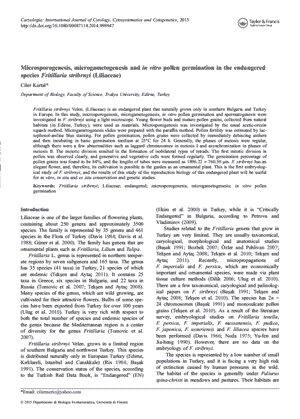NEWS 2015
Microsporogenesis, microgametogenesis and in vitro pollen germination in the endangered species Fritillaria stribrnyi (Liliaceae)
Ciler Kartal
Caryologia: International Journal of Cytology, Cytosystematics and Cytogenetics (2015)
doi:10.1080/00087114.2014.998947
Department of Biology, Faculty of Science, Trakya University, Edirne, Turkey
Abstract
Fritillaria stribrnyi Velen. (Liliaceae) is an endangered plant that naturally grows only in southern Bulgaria and Turkey in Europe. In this study, microsporogenesis, microgametogenesis, in vitro pollen germination and spermatogenesis were investigated in F. stribrnyi using a light microscope. Young flower buds and mature pollen grains, collected from natural habitats (in Edirne, Turkey), were used as materials. Microsporogenesis was investigated by the usual acetic-orcein squash method. Microgametogenesis slides were prepared with the paraffin method. Pollen fertility was estimated by lactophenol-aniline blue staining. For pollen germination, pollen grains were collected by immediately dehiscing anthers and then incubating in basic germination medium at 25°C for 24 h. Generally, the phases of meiosis were regular, although there were a few abnormalities such as laggard chromosomes in meiosis I and asynchronization in phases of meiosis II. The meiotic division resulted in the formation of isobilateral types of tetrads. The first mitotic division in pollen was observed clearly, and generative and vegetative cells were formed regularly. The germination percentage of pollen grains was found to be 84%, and the lengths of tubes were measured as 1896.22 ± 760.50 μm. F. stribrnyi has an elegant flower, and, therefore, its cultivation is possible in the garden as an ornamental plant. This is the first embryological study of F. stribrnyi, and the results of this study of the reproduction biology of this endangered plant will be useful for in vitro, in situ and ex situ conservation and genetic studies.

